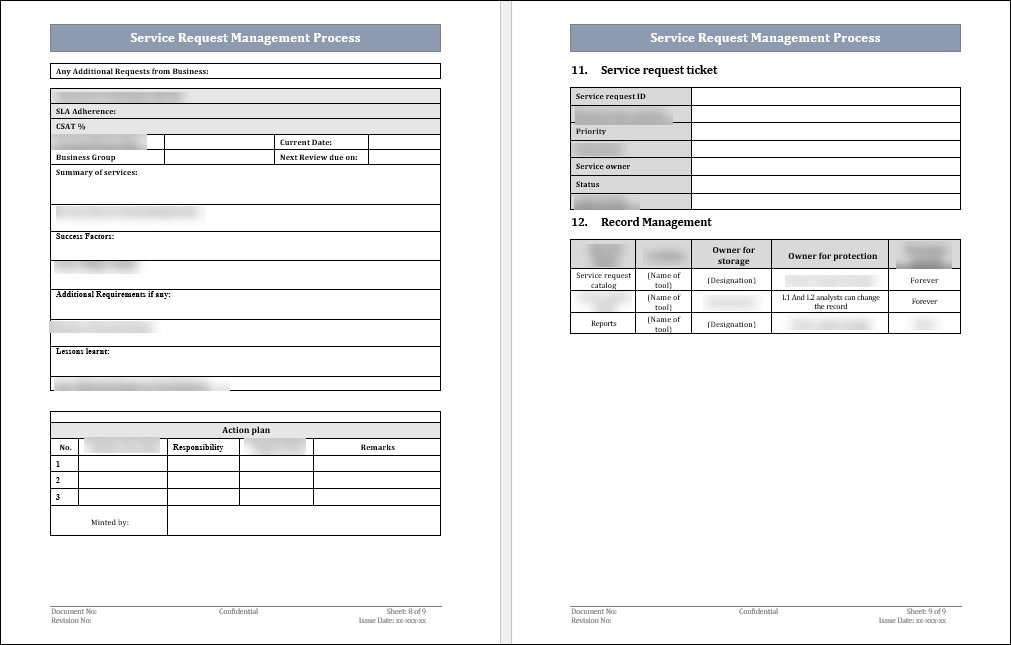Service Request Management Process Template
Introduction
A Service Request Management Process Template in IT Governance provides a standardised framework for managing and completing service requests inside an organization's IT infrastructure. This template illustrates an organised sequence of steps, from the first submission of a service request to its completion and closure. It consists of important components such as request submission channels, triage processes for categorization and prioritisation, approval workflows, execution and fulfilment procedures, and monitoring and reporting tools.

Scope Of Service Request Management Process Template
The Service Request Management (SRM) process is critical to IT governance, as it ensures the seamless and controlled delivery of IT services. In today's dynamic landscape of modern organisations, where technology serves as the backbone of operations, the SRM process is critical to efficiently handling user requests. The SRM process, by offering a standardised framework for submitting, categorising, prioritising, and completing service requests, not only simplifies operational workflows but also adds to overall governance strategy.
Steps To Implement Service Request Management Process Template
Step 1: Request Submission
- Set up numerous methods for submitting requests, such as online forms, emails, and service portals.
- Clearly specify the information required to complete the request.
- Implement a user-friendly interface to make the submission process easier.
Step 2: Request Triage
- Classify incoming requests using specified categories.
- Conduct a first assessment to identify the request's nature and complexity.
- Prioritise requests using established criteria and urgency.
Step 3: Approval Workflow
- Define an approval hierarchy that outlines the levels and roles involved in the permission process.
- Implement a workflow for acquiring appropriate approvals before moving forward with request fulfilment.
- Ensure adherence to organisational policies and regulatory requirements.
Step 4: Execution and Fulfillment
- Assign tasks to the right persons or teams in charge of fulfilling the request.
- Use automation techniques to improve task assignment and tracking.
- Communicate progress with the requestor and provide status updates as needed.
Step 5: Monitoring and Reporting
- Implement real-time monitoring to keep track on the status of active requests.
- Establish key performance indicators (KPIs) to assess the effectiveness of the SRM process.
- Create regular reports for management review and continual development.
Step 6: Closure and Feedback
- Verify that the request was successfully completed.
- Notify the requestor about the resolution and solicit feedback on the service given.
- Use feedback to discover areas for improvement in the SRM process.

Best Practices For Service Request Management Process Template
1. Standardization and Documentation: Standardise the procedure to provide consistency and clarity while addressing different sorts of service requests.
2. User-Friendly Request Submission: Design intuitive and user-friendly request submission interfaces to reduce the possibility of errors and incomplete information.
3. Automated Workflow and Task Assignment: Use automation solutions to streamline the workflow and job assignment procedures.
4. Prioritization and Categorization: Create a reliable system for categorising and prioritising service requests based on their urgency, influence on business operations, and organisational priorities.
5. Service Level Agreements (SLAs): Ensure that Service Level Agreements are reasonable, measurable, and aligned with organisational goals, including explicit expectations for request resolution timeframes.
Conclusion
The Service Request Management (SRM) Process Template is a cornerstone of IT Governance, providing organisations with an organised and standardised method to managing and fulfilling service requests. This precisely created template, adapted to organisational needs, is a strategic tool for reducing workflows, increasing productivity, and aligning IT services with larger business goals. Organisations who implement the SRM Process Template benefit from increased openness, accountability, and user satisfaction.


